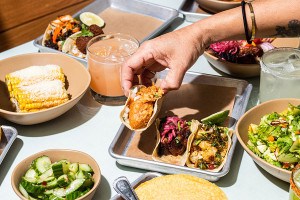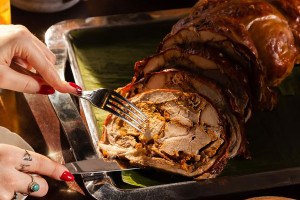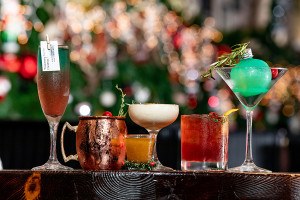How a Bad Day Led to the Southeast Asian Market’s Best-Selling Lemongrass Cheesesteak
Sahbyy Food's lemongrass cheesesteak often draws long lines at the Southeast Asian Market. Ahead of the market’s opening day, let's take a look back at how it all started — with 1,000 leftover beef sticks and a craving for a sandwich.

Sahbyy Food’s lemongrass cheesesteak / Photograph by Roland Bui
Welcome to Just One Dish, a Foobooz series that looks at an outstanding item on a Philly restaurant’s menu — the story behind the dish, how it’s made, and why you should be going out of your way to try it.
In 2022, Pidor Yang and her husband Yen were up into the night skewering cubes of lemongrass-tinged beef onto around 1,000 sticks by hand.
They were preparing for a Cambodian New Year festival at a Philadelphia temple the next day, where they planned to sell the grilled beef sticks. But soon after setting up, it became clear that no one was buying. The Yangs were new vendors at the temple and found themselves next to a regular selling the same thing. Many festival-goers had also brought their own food, and, to make matters worse, it was 90 degrees out — unseasonably hot for April — and less than ideal weather for standing around with a bunch of meat that could spoil. By mid-morning, the Yangs packed up and left, beef sticks in tow.
Pidor didn’t know what to do with all the leftovers, but she figured it didn’t make sense to take them to the Southeast Asian Market, where she’d begun selling Cambodian fare like chicken curry balls and pepper chips through her business, Sahbyy Food, and where she knew she’d only be competing with the many other vendors grilling in South Philly’s FDR Park.
Feeling defeated, Pidor went to a friend’s house to decompress, and Yen went home. Then, when he got hungry, he had the idea to make a sandwich with the beef. “He called me up really, really excited,” Pidor remembers. “He said, ‘Babe, you have to come home right now. I just made this sandwich, and it’s phenomenal.’”
Later, he made the sandwich for her, frying up chunks of beef and arranging them on toasted bread, along with a cheddar-cheese sauce and some papaya salad his mom had made, before sprinkling a handful of Sahbyy Food’s pepper chips on top. Pidor took a bite and was impressed. “I think we have something here,” she said.

The lemongrass cheesesteak / Photograph by Roland Bui
She was right. More than two years later, the sandwich — now known as the lemongrass cheesesteak and made with beef or chicken — has become one of Sahbyy Food’s most popular items at the Southeast Asian Market. And come May 4, when the market will open for its 2024 season, the cheesesteak will make an appearance for the third year in a row.
Controversially, I’m not a big fan of cheesesteaks. But last summer, I tried both beef and chicken versions and was pleasantly surprised to find a cheesesteak that I actually liked. The meat is cooked just right — tender to the point that it almost falls apart with a bite, and flavored with Pidor’s zippy, homegrown lemongrass — while the papaya salad adds a welcome crunch in contrast to the gooey cheddar sauce and gently toasted hoagie roll it’s all served on. Then, there’s the pepper-chip garnish, adding some spice to the mix, and a pinch of cilantro to bring out the freshness of the lemongrass and give the cheesesteak an elevated look.
I’d gotten to the market in the morning, so I didn’t have to wait long for my cheesesteak, but one day in 2023, Pidor tells me, people queued for as long as two hours to get their hands on one. She estimates that she sold around 300 per weekend last year. “It was insane,” she says of the attention, noting that Instagrammers posting photos of the cheesesteak helped it take off. At one point, Pidor says, she had to switch to a ticketing system rather than calling out people’s names as she had done when she began selling the cheesesteak in 2022.
Before selling the sandwich at the market, and after Yen came up with the creation, Pidor tinkered with certain components of the recipe.
“There was a lot of technique to just the papaya salad itself,” says the Sahbyy Food owner, who learned how to make it from her mother-in-law. Yen’s mom showed Pidor how to wash the papaya to reduce its bitterness — first, shredding the papaya, then scrubbing it with salt until it wilts, and then washing it out, repeating the process until it’s palatable. She also taught her to identify the kind of ginger to use (Pidor prefers the subtler taste of the younger variety over the more pungent flavor of older ginger) and prepare the garlic, which has to be “sliced and diced in a certain way” to enhance the flavor. Pidor was on her own, though, when it came to figuring out the amount of the ingredients since her mother-in-law didn’t measure them. Now, Pidor has it down to a science and weighs everything out ahead of time. “I’ll follow my recipe to a T,” she says.

Pidor Yang at the Sahbyy Food’s table in the SEA Market in FDR Park. / Photograph by Roland Bui
Of course, lemongrass is the key ingredient in Sahbyy Food’s cheesesteak. Pidor began growing her own lemongrass at home by using stalks from the market and cutting approximately 1.5 inches off the bottom, then placing that part in water to root before planting in either a pot or outside in her yard. “Whatever survives, I replant,” she says of her propagated lemongrass, which she’ll use again for the next season. “What doesn’t survive gets tossed, and I start the process all over again.”
Earlier in the growing season, before the leaves of the lemongrass appear, Pidor has to use the core of the plant for the paste; as the season progresses and the leaves grow, she’ll cut them off and use those. “Each part of the lemongrass has its own characteristics, flavor, and taste,” Pidor says, noting that she prefers using the leaves of the lemongrass for her paste since they’re “more vibrant in color” and lend a stronger flavor to the cheesesteak.
As with the papaya salad, Pidor found inspiration in family recipes for her lemongrass paste. “Everybody has their own different technique for making it,” she says. The Sahbyy Food founder developed her recipe for kreung (Khmer for lemongrass paste) by combining the methods she picked up from her mom, sister, and mother-in-law, as well as “the traditional way of making it,” which involves cutting all the ingredients into small pieces by hand and pounding them with a pestle and mortar (since Pidor has to make large quantities, she uses a blender instead). Without revealing her secret, she adds that the order in which each ingredient in the lemongrass paste — typically made with kaffir lime leaves, galangal root, turmeric, and garlic — is ground is important. “I kind of just put it together to try and make my own,” she says.

A package of Sahbyy Food’s roasted sesame and garlic fried pepper chips. / Photograph by Roland Bui
While the lemongrass paste gives the sandwich its signature flavor, Pidor says the pepper chips are “the most special thing that goes onto the cheesesteak.” Understandably, the business owner won’t share how she makes them — they’re a product she’s keen to keep building Sahbyy Food around, with the goal of getting her pepper chips onto shelves in Philly’s mom-and-pop stores. She says the pepper she uses isn’t something you can find at any store. “I buy that wholesale from a little company in New Mexico,” she says, adding that everything else that goes into making her pepper chips, from the sesame to the garlic, is sourced locally.
As for the other elements of the cheesesteak, they’re a little less involved. Pidor says she gets the meat from a restaurant depot and the bread and cheddar-cheese sauce from the supermarket. But what makes this cheesesteak so delicious is how simple and comforting it is, but with deeper, more complex flavors than you’d get from a traditional version — though Pidor enjoys those too, and isn’t above getting a cheesesteak from Pat’s or Geno’s.
Unlike the ones you’ll find at Pat’s or Geno’s, though, Sahbyy’s cheesesteak isn’t about trying to be better than one down the road. It’s a labor of love — a clever and resourceful dish created with the purpose of making a bad day better. I’d say it succeeded.


